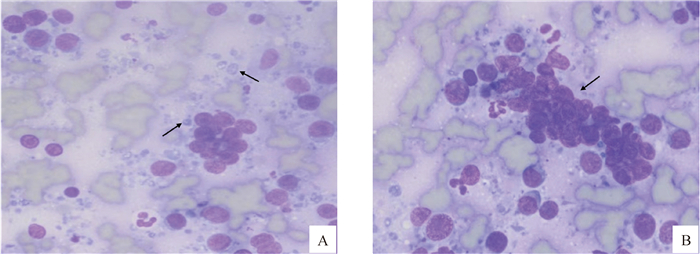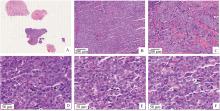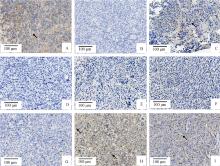





Acta Veterinaria et Zootechnica Sinica ›› 2025, Vol. 56 ›› Issue (6): 2948-2956.doi: 10.11843/j.issn.0366-6964.2025.06.037
• Basic Veterinary Medicine • Previous Articles Next Articles
ZHENG Yilei1,2( ), SHEN Fengting1,2(
), SHEN Fengting1,2( ), XIN Liang1, YUAN Xiwang1, LIN Lin3, CAO Di3, WU Jiusheng1,2, SHI Fushan1,2, WANG Huanan1,2,*(
), XIN Liang1, YUAN Xiwang1, LIN Lin3, CAO Di3, WU Jiusheng1,2, SHI Fushan1,2, WANG Huanan1,2,*( )
)
Received:2024-07-23
Online:2025-06-23
Published:2025-06-25
Contact:
WANG Huanan
E-mail:yileizheng@zju.edu.cn;22317101@zju.edu.cn;hnwang@zju.edu.cn
CLC Number:
ZHENG Yilei, SHEN Fengting, XIN Liang, YUAN Xiwang, LIN Lin, CAO Di, WU Jiusheng, SHI Fushan, WANG Huanan. Pathological and Immunohistochemical Analysis of A Case of Feline Nasal Malignant Neuroendocrine Neoplasm[J]. Acta Veterinaria et Zootechnica Sinica, 2025, 56(6): 2948-2956.
Table 1
Abnormal results of laboratory tests"
| 项目 Project | 结果 Result | 参考值 Reference value | 单位 Unit |
| 红细胞分布宽度 Red distribution width (RDW) | 29.4↑ | 15.0~27.0 | % |
| 血小板Platelet (PLT) | 0.23↓ | 1.51~6.00 | 105·μL-1 |
| 降钙素原Procalcitonin (PCT) | 0.04↓ | 0.17~0.86 | % |
| 活化部分凝血酶时间 Activated partial thromboplastin time (aPTT) | 25.0↓ | 60.0~115.0 | s |

Fig. 1
Cytologic results of Diff-Quick staining of nasal mass A. In the center of the field of view, there was an accumulation of vesicular naked nuclei with a large number of light blue lymphoid bodies (arrow); B. Microscopically, the tumor cells are nested and the tumor cells are ovoid (arrow)"


Fig. 3
Tumor pathology examination results (HE staining) A. Tumor and surrounding tissues, the tumor is located in the submucosal lamina propria, with no peripheral membrane; B, C. The tumor cell population shows infiltrative growth, with sheet-like infiltration in the dermis and muscle tissue, demonstrating marked invasiveness, 10×; D. The tumor cells display prominent nucleoli and overall moderate to high-grade atypia (arrow), 40×; E. Binucleated and multinucleated cells (arrow) can be observed, 40×; F. Vacuolar structures (arrows) are visible within the cytoplasm of tumor cells, 40×"


Fig. 4
Immunohistochemistry results (20×) A. NSE staining shows positive cytoplasmic immunoreactivity (arrow); B. CgA staining shows no immunoreactivity in tumor cells; C. Syn staining shows positive cytoplasmic immunoreactivity (arrow); D-G. CK, MAP-2, NeuN, and S-100 staining show no immunoreactivity in tumor cells; H. VIP staining shows strong positive cytoplasmic immunoreactivity (arrow); I. CD99 staining shows paranuclear positive (arrow)"

Table 2
Immunohistochemistry staining antibody information"
| 抗体 Antigen | 种属来源 Host species | 克隆性 Clonality | 稀释比 Dilution | 货号 Product number |
| 神经元特异性烯醇化酶 Neuron specific enolase (NSE) | 兔 Rabbit | 多克隆 Poly | 1:500 | GB11376-1 |
| 嗜铬粒蛋白A Chromorganin A (CgA) | 兔 Rabbit | 多克隆 Poly | 1:1 000 | GB111316 |
| 突触素 Synaptophysin (Syn) | 鼠 Mouse | 多克隆 Poly | 1:500 | GB15553 |
| 细胞角蛋白 Cytokeratin (CK) | 鼠 Mouse | 单克隆 Mono | 1:1 000 | GB122053 |
| 微管相关蛋白2 Microtubule associated protein 2 (MAP-2) | 兔 Rabbit | 多克隆 Poly | 1:2 000 | GB11128 |
| 神经元核 Neuronal nucleus (NeuN) | 鼠 Mouse | 单克隆 Mono | 1:500 | GB15138 |
| 钙结合蛋白 Soluble protein-100 (S-100) | 兔 Rabbit | 多克隆 Poly | 1:500 | GB11359 |
| 血管活性肠肽 Vasoactive intestinal peptide (VIP) | 兔 Rabbit | 多克隆 Poly | 1:500 | GB11279 |
| CD99 Cluster of differentiation 99 (CD99) | 兔 Rabbit | 多克隆 Poly | 1:100 | GB111064 |
| 1 |
INZANI F , PETRONE G , RINDI G . The new world health organization classification for pancreatic neuroendocrine neoplasia[J]. Endocrinol Metabol Clin, 2018, 47 (3): 463- 470.
doi: 10.1016/j.ecl.2018.04.008 |
| 2 |
KUWATA K , SHIBUTANI M , KEMMOCHI Y , et al. A neuroendocrine carcinoma of undetermined origin in a dog[J]. J Toxicol Pathol, 2010, 23 (3): 151- 155.
doi: 10.1293/tox.23.151 |
| 3 |
MUKARATIRWA S , VAN DER LINDE-SIPMAN J S , GRUYS E . Feline nasal and paranasal sinus tumours: clinicopathological study, histomorphological description and diagnostic immunohistochemistry of 123 cases[J]. J Feline Med Surg, 2001, 3 (4): 235- 245.
doi: 10.1053/jfms.2001.0141 |
| 4 |
VAN MAANEN C , KLEIN W R , DIK K J , et al. Three cases of carcinoid in the equine nasal cavity and maxillary sinuses: histologic and immunohistochemical features[J]. Vet Pathol, 1996, 33 (1): 92- 95.
doi: 10.1177/030098589603300114 |
| 5 |
KOEHLER J W , WEISS R C , AUBRY O A , et al. Nasal tumor with widespread cutaneous metastases in a golden retriever[J]. Vet Pathol, 2012, 49 (5): 870- 875.
doi: 10.1177/0300985811417250 |
| 6 | 孙悦, 刘玥, 匡宇, 等. 犬肝脏神经内分泌癌的病例报告[J]. 中国兽医杂志, 2023, 59 (4): 113- 117. |
| SUN Y , LIU Y , KUANG Y , et al. Case report of canine hepatic neuroendocrine carcinoma[J]. Chinese Journal of Veterinary Medicine, 2023, 59 (4): 113- 117. | |
| 7 |
PATNAIK A K , HURVITZ A I , LIEBERMAN P H . Canine hepatic neoplasms: a clinicopathologic study[J]. Vet Pathol, 1980, 17 (5): 553- 564.
doi: 10.1177/030098588001700504 |
| 8 | KUHN E , MORBINI P , CANCELLIERI A , et al. Adenocarcinoma classification: patterns and prognosis[J]. Pathologica, 2018, 110 (1): 5- 11. |
| 9 |
JASO J , MALHOTRA R . Adenoid cystic carcinoma[J]. Arch Pathol Lab Med, 2011, 135 (4): 511- 515.
doi: 10.5858/2009-0527-RS.1 |
| 10 | SIRSATH N T , BABU K G , DAS U , et al. Paranasal sinus neuroendocrine carcinoma: a case report and review of the literature[J]. Case Rep Oncol Med, 2013, 2013 (1): 728479. |
| 11 |
SAKO T , SHIMOYAMA Y , AKIHARA Y , et al. Neuroendocrine carcinoma in the nasal cavity of ten dogs[J]. J Comp Pathol, 2005, 133 (2-3): 155- 163.
doi: 10.1016/j.jcpa.2005.04.002 |
| 12 |
HARA K , SHIMADA A , MORITA T , et al. Olfactory neuroepithelioma in a dog: an immunohistochemical and electron microscopic study[J]. J Vet Med Sci, 2002, 64 (4): 391- 393.
doi: 10.1292/jvms.64.391 |
| 13 |
PATNAIK A K , NEWMAN S J , SCASE T , et al. Canine hepatic neuroendocrine carcinoma: an immunohistochemical and electron microscopic study[J]. Vet Pathol, 2005, 42 (2): 140- 146.
doi: 10.1354/vp.42-2-140 |
| 14 |
KORSE C M , TAAL B G , VINCENT A , et al. Choice of tumour markers in patients with neuroendocrine tumours is dependent on the histological grade. A marker study of chromogranin A, neuron specific enolase, progastrin-releasing peptide and cytokeratin fragments[J]. Eur J Cancer, 2012, 48 (5): 662- 671.
doi: 10.1016/j.ejca.2011.08.012 |
| 15 |
TAPIA F J , POLAK J M , BARBOSA A J A , et al. Neuron-specific enolase is produced by neuroendocrine tumours[J]. Lancet, 1981, 317 (8224): 808- 811.
doi: 10.1016/S0140-6736(81)92682-9 |
| 16 |
JUHLIN C C . Second-generation neuroendocrine immunohistochemical markers: reflections from clinical implementation[J]. Biology, 2021, 10 (9): 874.
doi: 10.3390/biology10090874 |
| 17 |
WIEDENMANN B , WALDHERR R , BUHR H , et al. Identification of gastroenteropancreatic neuroendocrine cells in normal and neoplastic human tissue with antibodies against synaptophysin, chromogranin A, secretogranin Ⅰ (chromogranin B), and secretogranin Ⅱ[J]. Gastroenterology, 1988, 95 (5): 1364- 1374.
doi: 10.1016/0016-5085(88)90374-5 |
| 18 |
ORYAN A , SARCHAHI A A , TAFTI A K , et al. Canine nasal neuroendocrine carcinoma: case report with a brief literature review[J]. Comp Clin Pathol, 2015, 24, 1257- 1259.
doi: 10.1007/s00580-015-2094-z |
| 19 |
BROSINSKI K , JANIK D , POLKINGHORNE A , et al. Olfactory neuroblastoma in dogs and cats-a histological and immunohistochemical analysis[J]. J Comp Pathol, 2012, 146 (2-3): 152- 159.
doi: 10.1016/j.jcpa.2011.06.002 |
| 20 |
CAZZINI P , B CZKOWSKI P , MILLINS C , et al. What is your diagnosis? Fine-needle aspirate from a nasal mass in a dog[J]. Vet Clin Pathol, 2019, 48 (2): 367- 369.
doi: 10.1111/vcp.12746 |
| 21 |
LIU Y , SAAD R S , SHEN S S , et al. Diagnostic value of microtubule-associated protein-2 (MAP-2) for neuroendocrine neoplasms[J]. Adv Anat Pathol, 2003, 10 (2): 101- 106.
doi: 10.1097/00125480-200303000-00005 |
| 22 |
HIROSE T , SCHEITHAUER B W , LOPES M B S , et al. Olfactory neuroblastoma. An immunohistochemical, ultrastructural, and flow cytometric study[J]. Cancer, 1995, 76 (1): 4- 19.
doi: 10.1002/1097-0142(19950701)76:1<4::AID-CNCR2820760103>3.0.CO;2-E |
| 23 |
PATNAIK A K , LUDWIG L L , ERLANDSON R A . Neuroendocrine carcinoma of the nasopharynx in a dog[J]. Vet Pathol, 2002, 39 (4): 496- 500.
doi: 10.1354/vp.39-4-496 |
| 24 | TSUTSUMI Y , YAZAKI K , YOSHIOKA K . A typical carcinoid tumor of the lung, associated with giant-cell transformation in bone metastasis[J]. Acta Pathol Jap, 1990, 40 (8): 609- 615. |
| 25 |
HESS E . Nonspecificity of p30/32MIC2 immunolocalization with the 013 monoclonal antibody in the diagnosis of Ewing's sarcoma: application of an algorithmic immunohistochemical analysis[J]. Appl Immunohistochem, 1997, 5, 94- 103.
doi: 10.1097/00022744-199706000-00004 |
| 26 |
RAJAGOPALAN A , BROWNING D , SALAMA S . CD99 expression in Merkel cell carcinoma: a case series with an unusual paranuclear dot-like staining pattern[J]. J Cuta Pathol, 2013, 40 (1): 19- 24.
doi: 10.1111/cup.12049 |
| 27 |
GOTO A , NIKI T , TERADO Y , et al. Prevalence of CD99 protein expression in pancreatic endocrine tumours (PETs)[J]. Histopathology, 2004, 45 (4): 384- 392.
doi: 10.1111/j.1365-2559.2004.01967.x |
| 28 |
DOMÍNGUEZ-MALAGÓN H R , MICHAL M , KAZAKOV D V , et al. Utility of CD99 paranuclear expression in the differential diagnosis of Merkel cell carcinoma[J]. Int J Surg Pathol, 2016, 24 (4): 293- 296.
doi: 10.1177/1066896915623361 |
| 29 |
SANKARAN R , BIN SYED HAMZAH S Z , KUMAR R , et al. Primitive neuroectodermal tumor (PNET) of nasal cavity[J]. East J Med, 2016, 21 (2): 101.
doi: 10.5505/ejm.2016.69937 |
| 30 |
ALVARENGA H H R , GUIFARRO J J , DÍAZ F , et al. Small cell neuroendocrine carcinoma in maxillary sinus: a case report and literature review[J]. Int J Surg Case Rep, 2024, 124, 110321.
doi: 10.1016/j.ijscr.2024.110321 |
| 31 |
PATNAIK A K , POST G S , ERLANDSON R A . Clinicopathologic and electron microscopic study of cutaneous neuroendocrine (Merkel cell) carcinoma in a cat with comparisons to human and canine tumors[J]. Vet Pathol, 2001, 38 (5): 553- 556.
doi: 10.1354/vp.38-5-553 |
| 32 |
MENZ A , GORBOKON N , VIEHWEGER F , et al. Pan-keratin immunostaining in human tumors: A tissue microarray study of 15, 940 tumors[J]. Int J Surg Pathol, 2023, 31 (6): 927- 938.
doi: 10.1177/10668969221117243 |
| 33 |
LLOYD R V . Practical markers used in the diagnosis of neuroendocrine tumors[J]. End Pathol, 2003, 14, 293- 301.
doi: 10.1385/EP:14:4:293 |
| 34 |
BAUDIN E , GIGLIOTTI A , DUCREUX M , et al. Neuron-specific enolase and chromogranin A as markers of neuroendocrine tumours[J]. Br J Cancer, 1998, 78 (8): 1102- 1107.
doi: 10.1038/bjc.1998.635 |
| 35 |
SALAMA A , BADAWY O , MOKHTAR N . Ki-67 is a powerful tool for grading neuroendocrine tumors among Egyptian patients: a 10-year experience[J]. J Cancer Res Clin Oncol, 2014, 140, 653- 661.
doi: 10.1007/s00432-014-1603-9 |
| 36 |
REKHI B , VOGEL U , BASAK R , et al. Clinicopathological and molecular spectrum of ewing sarcomas/PNETs, including validation of EWSR1 rearrangement by conventional and array FISH technique in certain cases[J]. Pathol Oncol Res, 2014, 20, 503- 516.
doi: 10.1007/s12253-013-9721-2 |
| [1] | PAN Hua, SUN Lei, ZHANG Jun, LIU Lili, MA Wengang, CAO Aizhi, LV Mingbin. Research Progress in Antimicrobial Mechanism and Structural Modification of Bile Acids [J]. Acta Veterinaria et Zootechnica Sinica, 2025, 56(6): 2546-2554. |
| [2] | SHI Shanshan, WAN Qiongfei, XU Yingxin, WANG Qiushuo, ZHANG Linlin, GUO Yiwen, HU Debao, GUO Hong, DING Xiangbin, LI Xin. Sequencing and Bioinformatics Analysis of miRNAs at Different Developmental Stages of Bovine Skeletal Muscle [J]. Acta Veterinaria et Zootechnica Sinica, 2025, 56(6): 2701-2710. |
| [3] | ZHOU Hongting, SUN Xinru, FAN Baochao, ZHANG Xuehan, ZHOU Jinzhu, SUOLANG Sizhu, SUN Min, GONG Ga, LI Bin. Inhibitory Effect of Monocyte Chemotactic Protein Induction Protein 3 on Porcine Epidemic Diarrhea Virus Replication in vitro [J]. Acta Veterinaria et Zootechnica Sinica, 2025, 56(6): 2847-2856. |
| [4] | CHEN Yunlong, FAN Gang, FAN Xinyi, GUO Yongchao, ZHANG Xinmiao, WANG Yan, ZHANG Shiqiang. Isolation and Identification of a Novel Porcine Circovirus Type 2d Strain with Multiple Nucleotide Substitutions [J]. Acta Veterinaria et Zootechnica Sinica, 2025, 56(6): 3032-3040. |
| [5] | WANG Shujuan, WANG Dongfang, MA Zhenyuan, ZHAO Xueli, LIU Ying, YANG Haibo, CHAI Mao, WANG Cui, YAN Ruoqian. Isolation, Identification and Evolutionary Analysis of a Strain of Senecavirus A [J]. Acta Veterinaria et Zootechnica Sinica, 2025, 56(6): 3041-3046. |
| [6] | WANG Qinqian, GAO Zhendong, LU Ying, MA Ruoshan, DENG Weidong, HE Xiaoming. Research Progress of Whole Genome Resequencing in Chinese Indigenous Cattle [J]. Acta Veterinaria et Zootechnica Sinica, 2025, 56(5): 2026-2037. |
| [7] | ZHAN Qingyu, DENG Juanli, LIU Hujun, YIN Peng, WANG Hongliang, LI Tiantian. Research Progress on the Toxicology and Detoxification Mechanisms of Zearalenone and Its Derivatives in Corn [J]. Acta Veterinaria et Zootechnica Sinica, 2025, 56(5): 2056-2069. |
| [8] | WU Qianhui, ZHANG Yu, ZHANG Taoni, MO Meilan. Research Progress on Mechanism of Lipid Raft Involved in Coronavirus Infection and Its Application [J]. Acta Veterinaria et Zootechnica Sinica, 2025, 56(5): 2112-2122. |
| [9] | ZHU Tao, YU Yang, CAI Richun, CHEN Zhiwu, ZHAO Guiping, CUI Huanxian, ZHENG Maiqing. Analysis of the Genetic Characteristics of Clutch Traits in the GF33A Line of Yellow-feathered Broilers [J]. Acta Veterinaria et Zootechnica Sinica, 2025, 56(5): 2136-2147. |
| [10] | QIAO Liying, WANG Wannian, ZHANG Li, PANG Zhixu, ZHANG Siying, LI Yifan, LIU Wenzhong. Machine Learning Methods for Sheep Breed Classification Based on Genomic Markers [J]. Acta Veterinaria et Zootechnica Sinica, 2025, 56(5): 2157-2167. |
| [11] | YAO Tingting, LI Hao, YAN Huixuan, CAO Yifan, Cirengluobu , Suolangquji , Nimacangjue , ZHAO Li, Danzengluosang , Silangwangmu , Basangzhuzha , CHEN Ningbo. Genetic Diversity of Mitochondrial Genome and Maternal Origin of 10 Cattle Populations in Tibet Autonomous Region [J]. Acta Veterinaria et Zootechnica Sinica, 2025, 56(5): 2194-2202. |
| [12] | WANG Yanan, GUO Yaru, JIANG Yanping, CUI Wen, LI Jiaxuan, LI Yijing, WANG Li. Isolation, Identification and Pathogenicity Analysis of Porcine Rotavirus [J]. Acta Veterinaria et Zootechnica Sinica, 2025, 56(5): 2259-2269. |
| [13] | HAN Yangrui, XIA Luming, LI Ruifang, ZHANG Manyu, DU Jingying, SUN Qing, LI Zenqiang, ZHAO Hongjin, WANG Quan. Establishment of Lanthanide Microsphere Immunochromatographic Test Strips for the Detection of Toxoplasma gondii Antibodies [J]. Acta Veterinaria et Zootechnica Sinica, 2025, 56(5): 2353-2363. |
| [14] | ZHANG Yu, CHENG Fanyu, YU Zhaorong, SHAO Ying, WEI Ningbo, CHEN Fangfang, WANG Zhenyu, SONG Xiangjun, TU Jian, QI Kezong*. Preparation, Identification, and Preliminary Application of Monoclonal Antibodies against Fowl Adenovirus Serotype 4 [J]. Acta Veterinaria et Zootechnica Sinica, 2025, 56(5): 2364-2371. |
| [15] | ZHU Qiuxiang, HU Yulin, ZHU Xinchao, ZHONG Yongcheng, DING Xiaoqing, JI Jinzhao, WANG Jingyu, JIA Kun, ZHANG Haiyang, LI Shoujun. Refinement of the Diagnostic Criteria for Acute Stress in Cats and Its Application in Clinical Trials of Gabapentin Tablets [J]. Acta Veterinaria et Zootechnica Sinica, 2025, 56(5): 2424-2437. |
| Viewed | ||||||
|
Full text |
|
|||||
|
Abstract |
|
|||||